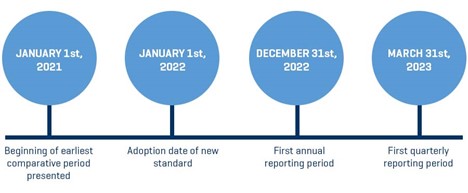
©metamorworks/iStock/Getty Images Plus
At this point, you have likely participated in enough webinars and other conversations to understand that the new lease standard, codified as Accounting Standard Codification (ASC) 842, brings operating leases onto the balance sheet. While you know it is coming and likely have a general sense of the adoption effort, the devil is in the details.
Timeline
Public business entities have already adopted the new lease guidance. For private companies, the standard is effective for fiscal years beginning after December 15, 2021 (and interim periods within fiscal years beginning after December 15, 2022). For calendar year companies, this implies the following timeline:

Depending on the transition method elected, the new accounting guidance can be applied back to the earliest period presented in the financial statements or prospectively from the effective date. The effective date of the new guidance, or adoption date, represents the point after which financial statements must reflect changes from the adoption of ASC 842, not necessarily the point at which all work must be completed.
With that in mind, and although the discount rate must be as of this date, other aspects of adoption (e.g., determining the completeness of your lease population, discussed further below) can be performed prior to the effective date. While some of these procedures could also take place after the effective date, it may be more complicated to unwind previously recorded journal entries. Ultimately, the more time that elapses, the more challenging the adoption will be.
Practical Expedients
The Financial Accounting Standards Board (FASB) has provided the following practical expedients, which may simplify the ASC 842 adoption process, particularly for private companies:
- The "package" of practical expedients: An entity can elect not to reassess lease classification, embedded leases, and initial direct costs. Note that this election is on an all-or-nothing basis, meaning you can't pick and choose between them. Also, this election does not waive the need for completeness procedures, discussed further below, as it assumes leases had previously been properly identified.
- Lessees may choose not to apply the new recognition guidance for leases with a term of 12 months or less. Instead of booking an ROU asset and lease liability, short-term lease expenses can continue to be recognized on a straight-line basis. The 12-month duration is based on the term from commencement, not leases with less than one year remaining at adoption.
- Non-lease components, such as common area maintenance (CAM), can be combined with the associated lease component in certain situations.
- Land easements can continue to be recorded in a manner consistent with prior accounting.
- Prior periods do not need to be restated under the new guidance when following the modified retrospective adoption approach.
- Non-public companies only: Ability to use the risk-free rate, rather than the incremental borrowing rate, to determine the lease liability (and the corresponding right of use asset) to be recorded on the balance sheet.
While some of these may appear to ease the burden related to implementation and the resulting audit implications, it is important to consider the current and future impacts of these practical expedients. For example, for entities that have a long-term plan to become a public company, you must unravel the private company expedients, such as the use of the risk-free rate, which creates potential future challenges. Additionally, the use of a risk-free rate will likely result in inflated lease liabilities and right-of-use assets when compared to discounting payments at the incremental borrowing rate, particularly considering the current interest rate environment.
Completeness
While private companies have the benefit of tailoring their implementation efforts based on lessons learned from their public company counterparts, the one theme that remains consistent for all companies implementing ASC 842 is ensuring that all lease and potential lease arrangements are captured in the adoption of, and future accounting under, ASC 842. Depending on the level of centralization of operations, specifically the contract execution and management function, identifying all arrangements that meet the definition of a lease in accordance with the standard, particularly those arrangements not historically identified as a lease, can be a significant undertaking. All companies should begin thinking about procedures to address this sooner rather than later and should begin to formulate an approach.
This is the single most critical step because, unlike prior off-balance sheet treatment for operating leases, each lease in the population directly impacts the balance sheet. As a result, not identifying all arrangements that meet the definition of a lease could result in a meaningful understatement of assets and liabilities. Read more on how to calculate the balance sheet impact of ASC adoption.
Common procedures to identify a complete population of leases include inquiries with department heads and a detailed review of vendor spend (i.e., accounts payable). After the initial adoption of the standard, most companies will need to implement new business processes to support the completeness assertion on an ongoing basis.